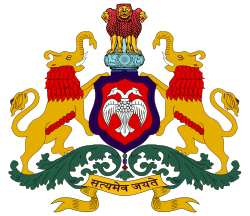Karnataka Legislative Assembly | |
|---|---|
| 16th Karnataka Assembly | |
 | |
| Type | |
| Type | of the Karnataka Legislature |
Term limits | 5 years |
| History | |
| Founded | 1881 |
| Preceded by | Mysore Legislative Assembly |
| Leadership | |
Leader of the House (Chief Minister) | |
Deputy Leader of the house (Deputy Chief Minister) | |
| Structure | |
| Seats | 224 |
 | |
Political groups | Government (136)[1][2]
Official Opposition (84) Vacant (4)
|
Length of term | 2023 – 2028 |
| Elections | |
| First past the post | |
First election | 26 March 1952 |
Last election | 10 May 2023 |
Next election | May 2028 |
| Meeting place | |
 | |
| Vidhana Soudha, Bengaluru, Karnataka, India. | |
 | |
| Suvarna Vidhana Soudha, Belagavi, Karnataka, India (Winter session) | |
| Website | |
| Karnataka Legislative Assembly | |
| Footnotes | |
| The Council was established in 1881 for the Princely State of Mysore. The princely state was merged with the Dominion of India and became Mysore State in 1947; Mysore State was re-organized to its current territorial state in 1956 and renamed as Karnataka on 1 November 1973. | |
The Karnataka Legislative Assembly (formerly the Mysore Legislative Assembly) is the lower house of the bicameral legislature of the southern Indian state of Karnataka. Karnataka is one of the six states in India where the state legislature is bicameral, comprising two houses: the Vidhan Sabha (lower house) and the Vidhan Parishad (upper house).[4] [5]
There are 224 Members of the Legislative Assembly (MLAs) and are directly elected by people through adult franchise. Karnataka is thus divided into 224 constituencies to elect members to the Assembly, each constituency electing one member. The assembly is elected using the simple plurality or "first past the post" electoral system. The elections are conducted by the Election Commission of India.
The normal term of the members lasts for five years. In case of death, resignation, or disqualification of a member, a by-election is conducted for constituency represented by the member. The party, or coalition which has the majority becomes the ruling party.
- ^ "Lata Mallikarjun officially joins Congress party". www.daijiworld.com. Retrieved 22 August 2024.
- ^ Gavali, Raju. "All 136 Congress MLAs made Siddaramaiah the Chief Minister: Laxmi Hebbalkar". Deccan Herald. Retrieved 22 August 2024.
- ^ Public TV (13 May 2023). Darshan Puttannaiah and Puttaswamy Gowda Extend Support To Congress | Public TV. Retrieved 22 August 2024 – via YouTube.
- ^ "Karnataka Legislative Assembly". kla.kar.nic.in. Archived from the original on 24 December 2016. Retrieved 28 December 2021.
- ^ "BJP-JD(S) tie-up: Regional party looking at outcome of NDA meeting on July 18". The Hindu. 16 July 2023. Archived from the original on 16 July 2023. Retrieved 16 July 2023.